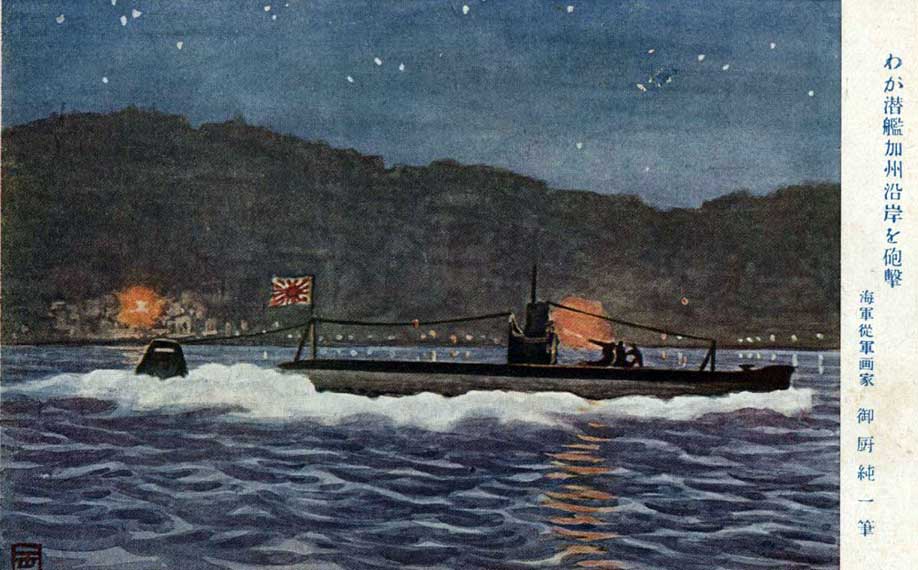Over the course of the Second World War, the continent of North America was largely spared the destruction seen elsewhere. Just as a moat protects a castle, the Atlantic and Pacific oceans protected the United States. American industry was able to support the war effort without interruption. This was not lost on the Axis who conceived several plans to attack the United States and interfere with the production of vital supplies. During World War II, Japan conducted several attacks against the United States. The first Japanese attack on the United States coast occurred on February 1942 when a Japanese sub shelled the US coast near Santa Barbara, California.
Following the attack on Pearl Harbor, Japan deployed several submarines to the West Coast of the United States. Despite seven submarines patrolling up and down the coast, they only managed to sink two merchant ships between them. Captain Kozo Nishino of the submarine I-17 decided on a new method of attack. He would shell targets ashore, threatening targets along the coast and terrifying the populace.
Only two months after the Attack on Pearl Harbor, Nishino was lurking off the coast of the United States. On February 23, Nishino guided the submarine I-17 along the United States coast. He chose the Ellwood Refinery as his primary target. Despite the darkness, Nishino found his target easily. The refinery was still in operation with a skeleton crew. Brillianrly lit up, it was an obvious target from the water.
Nishino ordered crew topside to man their weapon. Like a majority of Japanese submarines, I-17 was armed with a 14cm deck gun. A powerful weapon, it was larger than those carried aboard most other submarines. Once the weapon was ready, the crew aimed at a large aviation fuel tank. Around fifteen minutes past 7:00pm, a large boom split the night and the first shell raced to the refinery. It missed its target and instead struck a storage area. Unable to observe the fall of their shot and rocked by the ocean, the Japanese gunnery was not very accurate. It took several shells before the I-17 turned its attention to another fuel tank.
The small work crew at the refinery heard the explosion from the first shell. At first, they mistook the sound as a line rupture or gas tank explosion. It was not until they raced outside, that one of them spotted the I-17 just offshore. Now realizing that they were under attack, a frantic phone call was made to the local police station. Meanwhile, the I-17 continued to pump shells into the oil refinery. An oil derrick was destroyed along with other equipment, but the aviation fuel tanks that they were aiming at remained untouched. A half hour later, the I-17 ceased fire and left the area. Locals estimated that the Japanese sub fired as many as twenty-five shells that night.
Though several people had called the police to report the enemy submarine, no counter-attack was made. I-17 was able to get out of the area without any United States forces in pursuit and sail home to Japan.
Militarily speaking, the attack on the Ellwood Oil Refinery achieved very little. Damage to the refinery was light and it never even ceased operation to conduct repairs. However, the effects on the local populace was much more damaging. Thousands fled inland for fear of a Japanese invasion. A general panic spread throughout the western coast of the United States. Several people claimed to have seen the Japanese submarine flash signals to people on the shore. Others claimed that people signaled to the submarine for the coast, helping it locate its target. Authorities took these claims so seriously, that this event was used as a motive for the internment of Japanese-Americans during the war.
Following this event, I-17 returned to Japan. Her career afterwards was not particularly spectacular. She was stripped of some of her weapons and used to supply troops ashore during the Guadalcanal campaign. In 1943, she rescued survivors from the Battle of Bismarck Sea. The I-17 managed to torpedo one more ship in 1943, a Panamanian tanker that was transporting PT boats to the front lines. It wasn’t until August 19, 1943 that I-17 was finally sunk due to the efforts of a New Zealand Trawler and some United States floatplanes.
Further Reading and Other Links
Want to follow Navy General Board on Social Media? Check us out on the platforms below!
- YouTube
- The Navy General Board Forum
- Want to help the site continue to expand? Support us on Patreon.
More Great Articles
The USS Midway and her Greatest Carrier Landing
Life aboard a US Navy Battleship During the Korean War.
The Bayern Class vs. the Queen Elizabeth Class
The Malta Class: The Carriers that Never Were
The Last Naval Battle of World War II
Check out Awesome Guest Articles!
AAA Umbrella vs. Rain of Bombs
The post Japanese Attack on the United States Coast appeared first on Navy General Board.
